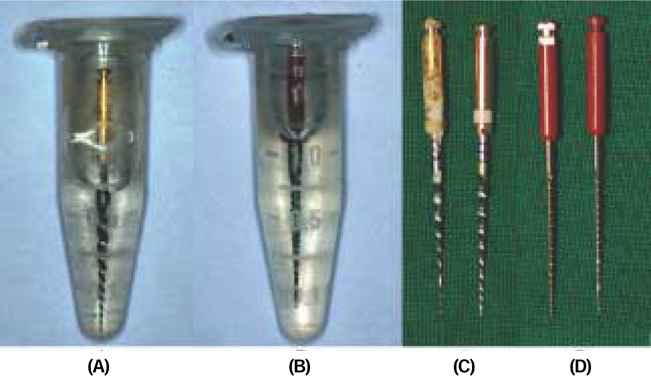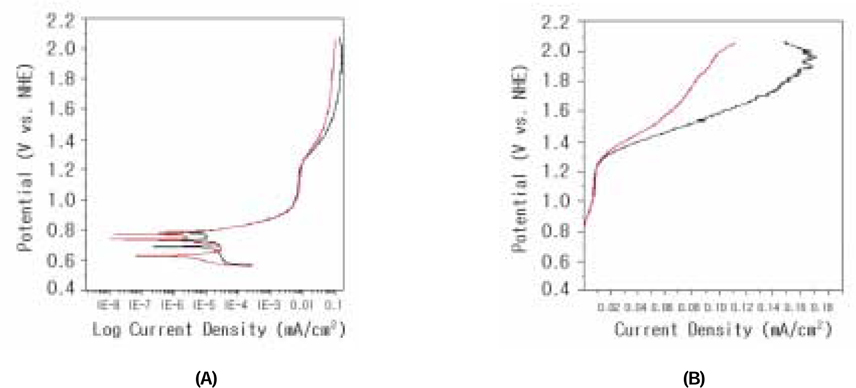J Korean Acad Conserv Dent.
2008 Jul;33(4):377-388. 10.5395/JKACD.2008.33.4.377.
Comparative analysis of various corrosive environmental conditions for NiTi rotary files
- Affiliations
-
- 1Department of Conservative Dentistry, School of Dentistry Pusan National University, Korea. golddent@pusan.ac.kr
- KMID: 2176005
- DOI: http://doi.org/10.5395/JKACD.2008.33.4.377
Abstract
- The aim of the present study is to compare the corrosion tendency using two kinds of NiTi files in the various environmental conditions through the visual examination and electrochemical analysis. ProTaper Universal S2, 21 mm (Dentsply Maillefer, Ballaigues, Switzerland) and Hero 642, 0.06 tapers, size 25, 21 mm (Micromega, Besancon, France) rotary instruments were tested. The instruments were randomly divided into eighteen groups (n = 5) by the immersion temperature, the type of solution, the brand of NiTi rotary instrument and the presence of mechanical loading. Each file was examined at various magnifications using Scanning Electron Microscope (JEOL, Akishima, Tokyo, Japan) equipped with energy dispersive X-ray microanalysis (EDX). EDX was used to determine the components of the endodontic file alloy in corroded and noncorroded areas. The corrosion resistance of unused and used NiTi files after repeated uses in the human teeth was evaluated electrochemically by potentiodynamic polarization test using a potentiostat (Applied Corrosion Monitoring, Cark-in-Cartmel, UK). Solution temperature and chloride ion concentration may affect on passivity of NiTi files. Under the conditions of this in vitro study, the corrosion resistance is slightly increased after clinical use.
Keyword
MeSH Terms
Figure
Cited by 1 articles
-
Corrosion resistance assessment of nickel-titanium endodontic files with and without heat treatment
Tatiana Dias Costa, Elison da Fonseca e Silva, Paula Liparini Caetano, Marcio José da Silva Campos, Leandro Marques Resende, André Guimarães Machado, Antônio Márcio Resende do Carmo
Restor Dent Endod. 2020;46(1):e6. doi: 10.5395/rde.2021.46.e6.
Reference
-
1. Schilder H. Filling root canals in three dimensions. Dent Clin North Am. 1967. 723–744.
Article2. Schilder H. Cleaning and shaping the root canal. Dent Clin North Am. 1974. 18:269–296.3. Haapasalo M, Endal U, Zandi H, Coil JM. Eradication of endodontic infection by instrumentation and irrigation solutions. Endod Top. 2005. 10:77–102.
Article4. Zehnder M. Root canal irrigants. J Endod. 2006. 32:389–398.
Article5. Walia HM, Brantley WA, Gerstein H. An initial investigation of the bending and torsional properties of nitinol root canal files. J Endod. 1988. 14:346–351.
Article6. Martín B, Zelada G, Varela P, Bahillo JG, Magán F, Ahn S, Rodríguez C. Factors influencing the fracture of nickel-titanium rotary instruments. Int Endod J. 2003. 36:262–266.
Article7. Luebke NH, Brantley WA, Alapati SB, Mitchell JC, Lausten LL, Daehn GS. Bending fatigue study of nickel-titanium Gates Glidden drills. J Endod. 2005. 31:523–525.
Article8. Sotokawa T. An analysis of clinical breakage of root canal instruments. J Endod. 1988. 14:75–82.
Article9. Kuhn G, Tavernier B, Jordan L. Influence of structure on nickel-titanium endodontic instruments failure. J Endod. 2001. 27:516–520.
Article10. Zinelis S, Margelos J. Lambrianidis T, editor. Assessment of fracture mechanism of endodontic files. Risk Management in Root Canal Treatment. 2001. 1st edn. Thessaloniki, Greece: University Studio Press;239–243.11. Sarkar NK, Redmond W, Schwaninger B, Goldberg AJ. The chloride corrosion of four orthodontic wires. J Oral Rehabil. 1983. 10:121–128.12. Oshida Y, Sachdeva RCI, Miyazaki S. Microanalytical characterization and surface modification of NiTi orthodontic arch wires. Biomed Mater Eng. 1992. 2:51–69.
Article13. International ASM. ASM handbook, fatigue and fracture. 1996. vol.19. Materials Park, OH: ASM International.14. Firstov GS, Vitchev RG, Kumar H, Blanpain B, Van Humbeeck J. Surface oxidation of NiTi shape memory alloy. Biomaterials. 2002. 23:4863–4871.
Article15. Busslinger A, Sener B, Barbakow F. Effects of sodium hypochlorite on nickel-titanium lightspeed instruments. Int Endod J. 1998. 31:290–294.
Article16. Haikel Y, Serfaty R, Wilson P, Speisser JM, Allemann C. Cutting efficiency of nickel-titanium endodontic instruments and the effect of sodium hypochlorite treatment. J Endod. 1998. 24:736–739.
Article17. Haikel Y, Serfaty R, Wilson P, Speisser JM, Allemann C. Mechanical properties of nickel-titanium endodontic instruments and the effect of sodium hypochlorite treatment. J Endod. 1998. 24:731–735.
Article18. Kim H, Johnson JW. Corrosion of stainless steel, nickel-titanium, coated nickel-titanium and titanium orthodontic wires. Angle Orthod. 1999. 69:39–44.19. Stokes OW, Fiore PM, Barss JT, Koerber A, Gilbert JL, Lautenschlager EP. Corrosion in stainless-steel and nickel-titanium files. J Endod. 1999. 25:17–20.
Article20. O'Hoy PYZ, Messer HH, Palamara JE. The effect of cleaning procedures on fracture properties and corrosion of NiTi files. Int Endod J. 2003. 36:724–732.21. Darabara M, Bourithis L, Zinelis S, Papadimitriou GD. Susceptibility to localized corrosion of stainless steel and NiTi endodontic instruments in irrigating solutions. Int Endod J. 2004. 37:705–710.
Article22. Lee JK, Kim ES, Kang MW, Kum KY. The effect of surface defects on the cyclic fatigue fracture of HERO shaper Ni-Ti rotary files in a dynamic model: A fractographic analysis. J Korean Acad Conserv Dent. 2007. 32:130–136.
Article23. Huang HH. Effect of chemical composition on the corrosion behavior of Ni-Cr-Mo dental casting alloys. J Biomed Mater Res. 2002. 60:458–465.
Article24. Endo K, Sachdeva R, Araki Y, Ohno H. Effects of titanium nitride coatings on surface and corrosion characteristics of Ni-Ti alloy. Dent Mater J. 1994. 13:228–239.
Article25. Montero-Ocampo C, Lopez H, Salinas Rodriguez A. Effect of compressive straining on corrosion resistance of a shape memory Ni-Ti alloy in Ringer's solution. J Biomed Mater Res. 1996. 32:583–591.
Article26. Wever DJ, Veldhuizen AG, de Vries J, Busscher HJ, Uges DR, van Horn JR. Electrochemical and surface characterization of a nickel-titanium alloy. Biomaterials. 1998. 19:761–769.
Article27. Thierry B, Tabrizian M, Trepanier C, Savadogo O, Yahia L. Effect of surface treatment and sterilization processes on the corrosion behavior of NiTi shape memory alloy. J Biomed Mater Res. 2000. 51:685–693.
Article28. Trépanier C, Tabrizian M, Yahia LH, Bilodeau L, Piron DL. Effect of modification of oxide layer on NiTi stent corrosion resistance. J Biomed Mater Res. 1998. 43:433–440.
Article29. Burstein GT, Liu C, Souto RM. The effect of temperature on the nucleation of corrosion pits on titanium in Ringer's physiological solution. Biomaterials. 2005. 26:245–256.
Article30. Sirtes G, Waltimo T, Schaetzle M, Zehnder M. The effects of temperature on sodium hypochlorite short-term stability, pulp dissolution capacity, and antimicrobial efficacy. J Endod. 2005. 31:669–671.
Article31. Peters OA, Roehlike JO, Baumann MA. Effect of immersion in sodium hypochlorite on torque and fatigue resistance of nickel-titanium instruments. J Endod. 2007. 33:589–593.
Article32. Rondelli G, Vicentini B. Evaluation by electrochemical tests of the passive film stability of equiatomic Ni-Ti alloy also in presence of stress-induced martensite. J Biomed Mater Res. 2000. 51:47–54.
Article33. Angelini E, Zucchi F, Caputo A. Barbucci R, editor. Degradation processes on metallic surfaces. Integrated Biomaterial Science. 2002. Dordrecht: Kluwer Academic - Plenum Publishers;308–323.
Article34. Iijima M, Endo K, Yuasa T, Ohno H, Hayashi K, Kakizaki M, Mizoguchi I. Galvanic corrosion behavior of orthodontic archwire alloys coupled to bracket alloys. Angle Orthod. 2006. 76:705–711.
- Full Text Links
- Actions
-
Cited
- CITED
-
- Close
- Share
- Similar articles
-
- Effect of surface defects and cross-sectional configuration on the fatigue fracture of NiTi rotary files under cyclic loading
- Mechanical and geometric features of endodontic instruments and its clinical effect
- Lifetime and fracture patterns of NiTi rotary files in molars
- Stress distribution of three NiTi rotary files under bending and torsional conditions using 3-dimensional finite element analysis
- Comparative study on morphology of cross-section and cyclic fatigue test with different rotary NiTi files and handling methods





